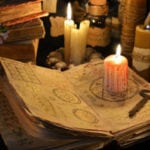 Politics
Politics  Politics
Politics  Weird Stuff
Weird Stuff Ten Bizarre Facts About The Doge Meme
 Our World
Our World 10 Ways Your Christmas Tree Is More Lit Than You Think
 Movies and TV
Movies and TV The 10 Coolest Stars to Set Sail on The Love Boat
 History
History 10 Things You Didn’t Know About the American National Anthem
 Technology
Technology Top 10 Everyday Tech Buzzwords That Hide a Darker Past
 Humans
Humans 10 Everyday Human Behaviors That Are Actually Survival Instincts
 Animals
Animals 10 Animals That Humiliated and Harmed Historical Leaders
 History
History 10 Most Influential Protests in Modern History
 Creepy
Creepy 10 More Representations of Death from Myth, Legend, and Folktale
 Politics
Politics 10 Political Scandals That Sent Crowds Into the Streets
 Weird Stuff
Weird Stuff Ten Bizarre Facts About The Doge Meme
 Our World
Our World 10 Ways Your Christmas Tree Is More Lit Than You Think
Who's Behind Listverse?

Jamie Frater
Head Editor
Jamie founded Listverse due to an insatiable desire to share fascinating, obscure, and bizarre facts. He has been a guest speaker on numerous national radio and television stations and is a five time published author.
More About Us Movies and TV
Movies and TV The 10 Coolest Stars to Set Sail on The Love Boat
 History
History 10 Things You Didn’t Know About the American National Anthem
 Technology
Technology Top 10 Everyday Tech Buzzwords That Hide a Darker Past
 Humans
Humans 10 Everyday Human Behaviors That Are Actually Survival Instincts
 Animals
Animals 10 Animals That Humiliated and Harmed Historical Leaders
 History
History 10 Most Influential Protests in Modern History
 Creepy
Creepy 10 More Representations of Death from Myth, Legend, and Folktale
10 Of History’s Most Prolific Con Artists And Their Famous Cons
The 19th century saw the emergence of a new type of criminal—the confidence man. Nowadays better known as a con artist, his tactics involve finding a suitable victim (referred to as a “mark” or “sucker”), gain their trust, and then defraud them out of money or property. When the job is executed well, the target doesn’t even know he is being conned and will part with his money with a smile on his face.
Cons started off small and have become bigger and more complicated. The so-called “long con” can take place over days, weeks, or even years and employ teams of swindlers, sets, and props, resembling more a theater production than criminal activity. That’s probably why cons have entered pop culture. Most people can appreciate a good flimflam for its creativity and audacity, as long as they’re not the marks.
The following 10 con artists wrote the book on how to bamboozle.
10 William Thompson

The crimes of William Thompson weren’t particularly brazen. But seeing as how he was the first person described as a “confidence man,” they are historically significant.
Thompson was active in mid-19th-century New York City. Sporting a genteel appearance and courteous demeanor, he would walk up to affluent strangers and strike up a conversation, acting like an old acquaintance.
After a few minutes of chitchat, Thompson politely asked his interlocutor if they had the confidence to trust him with their watch until the next day. Other times, he requested a small money loan and, bafflingly, people obliged. The Confidence Man walked away with the goods while his marks sat there unsure of what had just transpired.[1]
Thompson was arrested in July 1849 at the behest of Thomas McDonald, one of his victims. A couple of months earlier, The Confidence Man had approached McDonald on the street and, using his regular tactics, walked away with a gold lever watch worth $110. When the two ran into each other again, McDonald alerted a police officer who arrested Thompson despite his protestations and attempts to fight.
9 Oscar Hartzell

In 1915, the mother of Oscar Hartzell invested $6,500 in a scam. Along with many other Americans from the Midwest, she believed that they stood to make a fortune by taking the British government to court over the improperly probated estate of famed 16th-century adventurer Sir Francis Drake. At first, the con targeted only people with the surname Drake, who were made to believe that they were the descendants of the wealthy explorer. But it proved so successful that it spread to anyone willing to invest.
Oscar Hartzell believed the opportunity to be legit. In fact, the people behind the scam, a woman named Sudie Whittaker and her lawyer, Milo Lewis, even hired Hartzell as a recruiter.
It wasn’t until a few years later when they went to England that Hartzell understood the con. He wanted in. He even took advantage of infighting between Lewis and Whittaker to take over the racket. The scam continued for 15 years while Hartzell lived the good life in London. It wasn’t until 1933 that a postal inspector finally exposed the con and got Hartzell deported to the US.[2]
Although Hartzell was sentenced to 10 years, he still managed to keep the scam going for another year with the help of his brother. By the end, the swindler had conned tens of thousands of people, making $20,000 a month at the peak of the fraud.
8 Hungry Joe

Joseph Lewis (aka Hungry Joe) was a prolific swindler who was active in late 19th-century New York. His con of choice involved enticing rich marks into fixed matches of bunco, a popular parlor game of the time. Lewis was so successful that he earned the moniker “king of the Bunco Men.”
Hungry Joe’s notoriety came from some of his high-profile targets whom he swindled out of thousands of dollars. They included General John A. Logan, New York Judge Noah Davis, and politician Charles Francis Adams, son of John Quincy Adams.
His most famous catch was Oscar Wilde.[3] During the author’s United States tour of 1882, Lewis managed to take him for $5,000 in a bunco game. Fortunately for Wilde, he paid with a check that he managed to invalidate before it was cashed.
Although Lewis was well-known to the authorities, he was finally convicted in 1885 while trying to swindle a visiting British manufacturer named Joseph Ramsden. Hungry Joe went through his routine. He posed as a respectable businessman, gained Ramsden’s trust, and then gently “encouraged” a game of bunco.
However, his target was still reticent. So, in a panic move, Lewis just took his money and ran. He was subsequently caught by police, identified by Ramsden, and sentenced to four years in prison. When Hungry Joe got out, he was almost immediately convicted of another con and given another 10 years.
7 Lord Gordon Gordon

His real name is lost to history, as are his origins. He was a 19th-century British swindler who posed as a nobleman and successfully convinced others to part with large sums of money.
His first appearance in the record books happened in 1868 when he attempted to secure a Scottish estate by posing as Lord Glencairn. Eventually, he was found out and fled to America but not before convincing multiple banks, law firms, and a jeweler of his noble credentials.
The swindler emerged in Minnesota as Lord Gordon Gordon where he showed particular interest in the developing railway. According to a contemporary report, Colonel J. Loomis, land commissioner for the Northern Pacific Railway, spent $45,000 of the railroad’s money courting and securing Lord Gordon as a client in the belief that he would invest millions in return.[4]
In 1872, Gordon went to New York where he encountered his biggest target—Jay Gould, one of the richest (and most ruthless) businessmen of the Gilded Age. His lordship convinced the railroad developer that he had control over 60,000 shares of the Erie Railway.
Gould bribed him with around $1 million in stock and $200,000 in cash to assign the directors, basically granting him control over the line. It took two weeks before he realized that Gordon was a con man. Gould sued, but the lord had cashed in his stock by then and fled to Canada.
Gould unsuccessfully tried to have Lord Gordon extradited and even kidnapped. The swindler was almost in the clear, but in 1874, he was identified as Lord Glencairn by Marshall & Sons, the Edinburgh jeweler that he had fleeced for £25,000. Rather than face deportation, Lord Gordon hosted a farewell party in Manitoba and then committed suicide.
6 Henri Lemoine

If you google “how to make diamonds,” you will find countless results of “surefire” methods detailing how you could manufacture your own diamonds in the comfort of your home. Turns out that this scam is over 100 years old and was first employed by French con man Henri Lemoine.
In 1905, Lemoine claimed to have developed a technique of making diamonds from coal and secured an audience with several executives from De Beers, including Sir Julius Wernher. The demonstration took place in Lemoine’s laboratory in Paris.
The inventor got naked to assure his audience that he wasn’t hiding diamonds on his person. Then he placed coal and some mystery chemicals in a crucible and stuck it in a furnace. After it cooled, Lemoine went through the mixture and uncovered 20 small diamonds. He successfully repeated the procedure to persuade his patrons.[5]
Wernher was convinced enough to offer Lemoine a sum of money to keep his formula a secret with an option to buy it later, as well as funding for him to continue his research. One article in Le Figaro estimated that Wernher paid the inventor over 1.5 million francs over three years. Other people also invested, including writer Marcel Proust.
In 1908, a Parisian jeweler revealed that they sold the diamonds to Lemoine and he was indicted for fraud. He was unable to replicate the method in front of the court but left the country before being sentenced. Proust immortalized the event in The Lemoine Affair.
5 Lou Blonger

Born in 1849 in Vermont, Lou Blonger joined the Union Army when he was just 14 years old. After the Civil War, he reunited with his elder brother, Sam. They made their way through the American frontier, engaging in the occasional prospecting, gambling, and grifting.
By the late 1880s, the Blonger brothers had settled in Denver. They opened several saloons and gambling halls, which were heavily reliant on tourists who were regularly swindled out of every cent they had.
The brothers were successful, and as the years went by, their ambitions increased. They invested in mining claims. They had the local police and politicians in their pocket. They even started a feud with fellow Wild West con man Soapy Smith and ran him out of town.
The Blonger brothers became the undisputed kings of Denver’s criminal underworld, a title they maintained for decades until Sam’s death in 1914. Their gang became known as the “Million-Dollar Bunco Ring.”
Blonger had offices all over town that resembled legit stock exchanges or betting parlors. His men would trick well-to-do marks into putting money on “sure things” such as stock market tips or rigged races. Of course, they lost every time.[6]
Some victims never realized that they had been swindled and left town penniless. Others went to the police. They tipped off Blonger and gave him time to clear out the offices, making the mark look like a liar or a loon.
4 William Elmer Mead

William Elmer Mead was an oddity among the grifter community. Due to his strict fundamentalist upbringing, he never drank, smoked, or swore. He also attended church on Sundays. This earned him the nickname “The Christian Kid,” but it didn’t stop Mead from defrauding marks of over $2 million over a 40-year career.
Mead was an innovator of the magic wallet, a classic scam where a mark and the con man find a wallet stuffed with money or important papers which belongs to an accomplice. After returning the lost item to its owner, he shows his gratitude by presenting his benefactors with some amazing, one-of-a-kind deal or investment opportunity.
The Christian Kid took the magic wallet to new heights in 1910 during the lead-up to the arrival of Halley’s Comet. His mark was a rich contractor.
At first, the con went as usual. The target and Mead found the wallet. Then they returned it to the owner, who was actually Mead’s shill. He took the duo out for lunch as a sign of gratitude and presented himself as a sports promoter. After talking business for a while, he came up with a brilliant idea: Why not lease his stadiums to the contractor during the off-season? He could fill them to the brim with people gathering to see Halley’s Comet.[7]
Of course, as an impartial third party, Mead enthusiastically endorsed the idea. Eventually, he and his confederate left with a check worth thousands of dollars. Mead successfully pulled off this con several times before the passing of Halley’s Comet.
3 John St. John Long

History is full of quacks, and one of the most successful was John St. John Long. Born in Ireland in 1798, Long first studied art but soon discovered that medical fraud was more lucrative.
In 1826, he announced that he had developed a cure for consumption (aka tuberculosis). His treatment involved two secret chemicals—one was inhaled as a vapor, and the other was rubbed onto the patient’s chest and back. The lotion contained turpentine which caused a painful sore through which the lung infection supposedly came to the surface and left the body.
Besides his medical “expertise,” Long was handsome and charming and soon managed to build a thriving practice on London’s Harley Street. Then, in 1830, he went on trial for the death of one of his patients. Long was found guilty of manslaughter but only fined £250, a sum which he paid on the spot. Just a month later, another patient died. But this time, Long was acquitted.
By this time, the medical world had turned on the man known as the “Handsome Hoaxer of Harley Street.” However, he still had wealthy, powerful friends among London’s elite. Long died in 1834, probably due to a riding accident. But a more satisfying story said that he died of consumption after refusing his own treatment.[8]
2 Reed Waddell

Born into a well-off family in Springfield, Illinois, Reed “Kid” Waddell didn’t seem like someone destined for a life of crime. However, a gambling habit forced his family to cut him off completely in his early twenties.
Waddell arrived in New York City in 1880 and got involved with the green goods game. This con involved printing secretive leaflets advertising the sale of “perfect” counterfeit money. It was aimed primarily at gamblers who wanted to bet using phony money or use it to cover up previous losses. The gamblers never got their goods, and it wasn’t like they could turn to the police for help.
Reed Waddell is credited with inventing the gold brick scam which, supposedly, earned him over $250,000. He would take a chunk of lead, gold-plate it, and fashion it into a gold bar. The little touches made it successful—such as applying the official markings and stampings and even inserting a plug of real gold in the middle, which he would remove and offer to give to a jeweler for authentication.[9]
Kid Waddell would sell these bricks for thousands of dollars, typically to wealthy farmers who were expecting to double or even triple their investments.
In his later years, Waddell partnered with fellow swindler Tom O’Brien. In the 1890s, the duo moved their operations to Paris. One night in 1895, they got into an argument (over money, of course) and O’Brien shot Waddell dead.
1 Victor Lustig

Victor Lustig became infamous as “the man who sold the Eiffel Tower twice.” He also conned Al Capone and got away with it. He repeatedly sold a tiny, useless box for tens of thousands of dollars. During his trial, a Secret Service agent aptly called him “the smoothest con man that ever lived.”
According to prison interviews, Lustig was born in a town named Hostinne in Austria-Hungary in 1890 to a dirt-poor family. However, attempts to find him in any records failed, so this is as believable as anything else he’s ever said.
He started off with small scams before moving on to working the ocean liners traveling between Europe and America. Here is where he used the “money box” scheme. Lustig sold a small mechanical box which supposedly copied $100 bills using radium. In reality, the box contained a few real bills which it slowly dished out before becoming worthless.[10]
In Paris, Lustig posed as a government official looking to sell the Eiffel Tower for scrap. Hosting a secretive meeting to which he invited several metal dealers, Lustig put on such a convincing show that the winning bidder gave him the money for the tower as well as a bribe. Later, Lustig pulled off the scam again. But the second mark went to the police, so Lustig fled France.
In America, he formed a counterfeiting ring. His fake $100 bills were so good that they even fooled bank tellers. The government was worried that they would shake confidence in the US dollar. Lustig was arrested in 1935, although he did escape once for a month. He was sentenced to 20 years at Alcatraz.
Read more about classic cons on 10 Classic Cons You’d Still Fall For and 10 Wacky Vintage Cures Con Artists Sold To The Masses.








